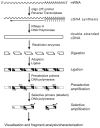Genetic and epigenetic alterations after hybridization and genome doubling
- PMID: 21082042
- PMCID: PMC2980832
Genetic and epigenetic alterations after hybridization and genome doubling
Abstract
Hybridization and polyploidization are now recognized as major phenomena in the evolution of plants, promoting genetic diversity, adaptive radiation and speciation. Modern molecular techniques have recently provided evidence that allopolyploidy can induce several types of genetic and epigenetic events that are of critical importance for the evolutionary success of hybrids: (1) chromosomal rearrangements within one or both parental genomes contribute toward proper meiotic pairing and isolation of the hybrid from its progenitors; (2) demethylation and activation of dormant transposable elements may trigger insertional mutagenesis and changes in local patterns of gene expression, facilitating rapid genomic reorganisation; (3) rapid and reproducible loss of low copy DNA sequence appears to result in further differentiation of homoeologous chromosomes; and (4) organ-specific up- or down-regulation of one of the duplicated genes, resulting in unequal expression or silencing one copy. All these alterations also have the potential, while stabilizing allopolyploid genomes, to produce novel expression patterns and new phenotypes, which together with increased heterozygosity and gene redundancy might confer on hybrids an elevated evolutionary potential, with effects at scales ranging from molecular to ecological. Although important advances have been made in understanding genomic responses to allopolyploidization, further insights are still expected to be gained in the near future, such as the direction and nature of the diploidization process, functional relevance of gene expression alterations, molecular mechanisms that result in adaptation to different ecologies/habitats, and ecological and evolutionary implications of recurrent polyploidization.
Figures

Similar articles
-
Allopolyploidy--a shaping force in the evolution of wheat genomes.Cytogenet Genome Res. 2005;109(1-3):250-8. doi: 10.1159/000082407. Cytogenet Genome Res. 2005. PMID: 15753584 Review.
-
Genome evolution in Oryza allopolyploids of various ages: Insights into the process of diploidization.Plant J. 2021 Feb;105(3):721-735. doi: 10.1111/tpj.15066. Epub 2020 Dec 8. Plant J. 2021. PMID: 33145857
-
Polyploidy and interspecific hybridization: partners for adaptation, speciation and evolution in plants.Ann Bot. 2017 Aug 1;120(2):183-194. doi: 10.1093/aob/mcx079. Ann Bot. 2017. PMID: 28854567 Free PMC article. Review.
-
Epigenetic phenomena and the evolution of plant allopolyploids.Mol Phylogenet Evol. 2003 Dec;29(3):365-79. doi: 10.1016/s1055-7903(03)00213-6. Mol Phylogenet Evol. 2003. PMID: 14615180 Review.
-
Genomic and Meiotic Changes Accompanying Polyploidization.Plants (Basel). 2022 Jan 3;11(1):125. doi: 10.3390/plants11010125. Plants (Basel). 2022. PMID: 35009128 Free PMC article. Review.
Cited by
-
Different genome-specific chromosome stabilities in synthetic Brassica allohexaploids revealed by wide crosses with Orychophragmus.Ann Bot. 2009 Jul;104(1):19-31. doi: 10.1093/aob/mcp099. Epub 2009 Apr 29. Ann Bot. 2009. PMID: 19403626 Free PMC article.
-
Inheritance and Variation of Genomic DNA Methylation in Diploid and Triploid Pacific Oyster (Crassostrea gigas).Mar Biotechnol (NY). 2016 Feb;18(1):124-32. doi: 10.1007/s10126-015-9674-4. Epub 2015 Nov 19. Mar Biotechnol (NY). 2016. PMID: 26585587
-
Suppression Subtractive Hybridization Versus Next-Generation Sequencing in Plant Genetic Engineering: Challenges and Perspectives.Mol Biotechnol. 2015 Oct;57(10):880-903. doi: 10.1007/s12033-015-9884-z. Mol Biotechnol. 2015. PMID: 26271955 Review.
-
Identification and Characterization of Verticillium longisporum Lineage A1/D1 from Brassica Crops in Manitoba, Canada.Int J Mol Sci. 2020 May 15;21(10):3499. doi: 10.3390/ijms21103499. Int J Mol Sci. 2020. PMID: 32429108 Free PMC article.
-
Genetic and Epigenetic Changes Are Rapid Responses of the Genome to the Newly Synthesized Autotetraploid Carassius auratus.Front Genet. 2021 Jan 7;11:576260. doi: 10.3389/fgene.2020.576260. eCollection 2020. Front Genet. 2021. PMID: 33488668 Free PMC article.
References
-
- Aagaard SM, Sastad SM, Greilhuber J, Moen A. A secondary hybrid zone between diploid Dactylorhiza incarnata ssp. cruenta and allotetraploid D. lapponica (Orchidaceae) Heredity. 2005;94:488–496. - PubMed
-
- Adams KL, Wendel JF. Novel patterns of gene expression in polyploid plants. Trends Genet. 2005a;21:539–543. - PubMed
-
- Adams KL, Wendel JF. Polyploidy and genome evolution in plants. Curr. Opin. Pl. Biol. 2005b;8:135–141. - PubMed
-
- Ainouche ML, Baumel A, Salmon A. Spartina anglica Hubbard: a natural model system for analysing early evolutionary changes that affect allopolyploid genomes. Biol. J. Linn. Soc. 2004;82:475–484.
Grants and funding
LinkOut - more resources
Full Text Sources
